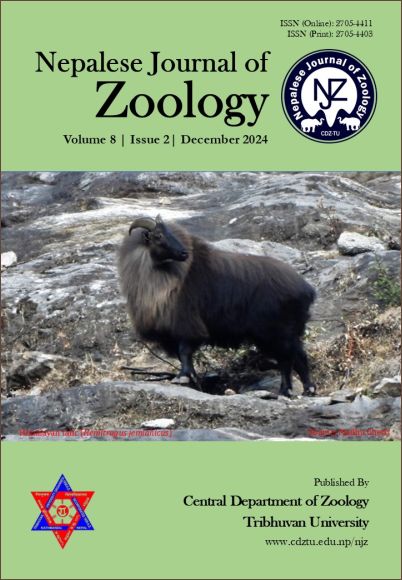Characterization and management of human-wildlife conflict in Judibela of Rautahat, Nepal
DOI:
https://doi.org/10.3126/njz.v8i2.74926Keywords:
crop-raiding, human injury, human-wildlife conflicts, livestock depredation, people's perceptionAbstract
The attitude of people towards target wildlife species plays an important role in determining whether the conservation plans be implemented. This study examined the analysis of human-wildlife conflict patterns and factors by utilizing data gathered from literature, government records, and a questionnaire survey. The study also evaluated the temporal and spatial occurrence of human casualties, crop damage, and livestock losses resulting from interactions with wildlife. Furthermore, the study assessed the local community's perspective on wildlife conservation as it pertains to the preservation of biodiversity. The Likelihood Ratio test was employed to establish the connection between socio-demographic factors and human-wildlife conflict (HWC) that shows an association between occupation and age groups with HWC. The study identified three primary forms of conflict between humans and wild animals: crop-raiding, livestock depredation, and human injuries. Maximum conflict incidences occurred in crop fields on average of (75.49%) in which human injury was recorded (66.67%) and Crop raiding 84.31%, followed by the settlement area (64.29%). A total of 87.13% respondents believed that wild boar is the most conflicted wild animal encountered more at night. The other reported monkey is the second most conflicted wild animal which encountered morning (26.73%), afternoon (27.72%), and evening (45.54%). The exponential decay analysis showed that the number of conflict incidences decreases with an increase in distances from the forest. The majority of respondents (86.15%) expressed a strong wish to conserve wild animals, recognizing their crucial role in maintaining ecosystem balance. Additionally, 93.07% of respondents indicated their intention to educate their children about the importance of biodiversity conservation. Despite their positive attitudes towards wildlife conservation and management, respondents also acknowledged the need for compensation in cases of losses caused by wild animals demonstrating their commitment to both sustainable conservation and practical considerations in wildlife interactions.
Downloads
Downloads
Published
How to Cite
Issue
Section
License
Copyright (c) 2024 The Author(s)

This work is licensed under a Creative Commons Attribution-NonCommercial 4.0 International License.
This license enables reusers to distribute, remix, adapt, and build upon the material in any medium or format for noncommercial purposes only, and only so long as attribution is given to the creator.

